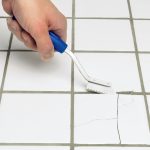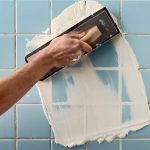Replacing grout isn’t routine maintenance. It doesn’t follow a prescribed schedule. However, it is something homeowners in Madison WI are likely to face. When grout does its job – locking tiles tight, keeping out water and giving tiled surfaces a finished look – it’s ignored. Only when it fails, is stained, cracked or missing do we take notice.
Years of wear and layers of dirt all take a toll. A strong degreasing agent may clean away stains – but avoid oil-based soaps that can stain grout themselves. Eventually, moisture and dirt penetrates the grout opening it up to cracking or the growth of mold and mildew. Normal settling of the house often damages grout, especially on floor and wall tiles.
New grout can be applied over existing grout but only as a temporary fix. The layer of new grout will be thin and uneven because the old grout surface is uneven. It won’t hold in places and the old grout is likely to show through. Removing the old material is the best solution for replacing grout. And, it isn’t as hard as it used to be. There are many specialized tools available today to assist in removing the old grout. In addition, there are specialized tools for apply it and new formulas that go on easier.
Reasons For Replacing Grout
Grout that’s cracked, missing or peeling should be replaced immediately. The longer you wait the more chance of moisture reaching the surface below and creating bigger problems.
You’ll find that grout absorbs dyes and minerals and gets stained by hard water. It usually doesn’t need to be replaced if it is just discolored. Cleaning and resealing does the job.
Grout that shows signs of mold or mildew is another matter. Grout is porous so when mold gets started it grows deep beneath the surface, too. Mold in grout weakens the material. Not only does it weaken the tile around it, it is a health concern, too. When mold or mildew is lurking in bathroom, laundry room, mud room or kitchen it’s time to regrout.
Maybe replacing grout is not the answer. Before you chip out the old grout, formulate a new mixture and go through the process there are options. Check for loose or cracked tiles first. If there are broken tiles you’ll have to replace them. When replacing tiles or grout use a mold or mildew killing solution on the edges of new and existing tiles to ensure that any remaining mold spores can’t spread. Allow it all to dry thoroughly before replacing grout.
Choosing The Right Grout
Grout comes in two basic types: cement grout and epoxy grout. The best choice depends upon the width of the space between tiles. Either works well with most tiles.
Cement Grout — Cement grout comes in two types: sanded and unsanded. Narrow joints of 1/8-inch or smaller get unsanded grout. That’s a mixture of Portland cement and powdered grout pigments mixed to the consistency of pudding with water. Joints wider than 1/8-inch get sanded grout – the same mixture with sand added. Adding sand bulks up the mixture and keeps it from shrinking too much in the wider openings. Modern grouts use polymer additives to ensure color quality and increased flexibility. Today’s grouts work in joint widths up to 1 1/4 inches wide. Wide joints often camouflage irregularities in handmade tiles. However, even with their improvements cementitious grouts are porous and will stain. That’s the main reason for sealing grout after it has cured and is completely dry.
Epoxy Grout — in areas exposed to harsh conditions, epoxy grout is the answer. Created by mixing two parts – resin and hardener – epoxy grouts also come in sanded and unsanded versions. Epoxy grouts have a reputation for being unforgiving and hard to apply. However the new generation contains detergents in the hardeners that make cleanup with water easier. And they are easier to work with. Epoxy discolors porous surfaces like unglazed quarry tiles. These tiles must be sealed before replacing grout. This type grout is stain resistant and very durable making it ideal for kitchens and heavy traffic areas.
Consult A Professional Before Replacing Grout
Both types of grout benefit from the use of a top-quality sealer. Grout sealers also come in two varieties: membrane-forming and penetrating. The first is more likely to peel or getting cloudy. That’s because residual moisture from mastic or underlayments rise to the surface of the tile. Penetrating sealers are preferred because they breathe after soaking into tile and grout.
The tile professionals at Molony Tile apply years of experience and training to every tile project. They deal with the latest tile, grout and related tools. They know the trends and understand the pros and cons of many tile options..
Contact Molony Tile for a consultation and to browse a complete selection of the newest tiles and supplies. Molony is Madison’s Number One source for unique, durable and elegant tile solutions. Call or email Molony Tile, 608-268-8453 to discuss tile options and solutions for replacing grout in your Madison WI home.


